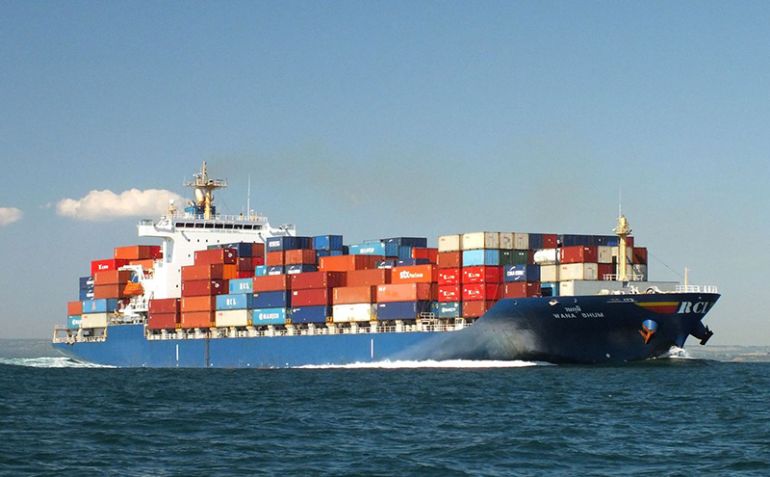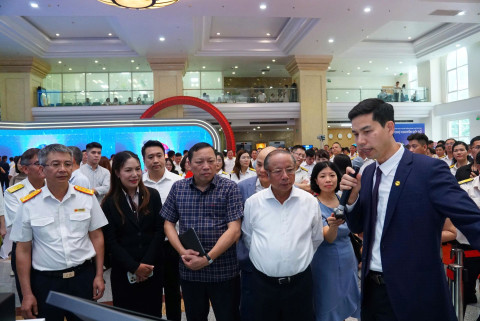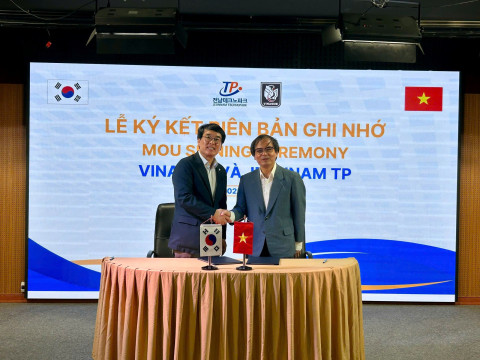Export businesses face difficulties as sea freight rates rise
- 149
- Business
- 16:02 22/07/2024
DNHN - Logistics costs have now increased by about 130% compared to the end of 2023. This reality has been pushing domestic export businesses into a state of freezing many export orders.

Shipping rates from Vietnam to other countries are now approximately the same as during the COVID period
According to the General Statistics Office, in the first six months of 2024, the total import-export value of the country reached 369.62 billion USD, an increase of 16% compared to the same period last year. Of which, export value reached 190.73 billion USD, up 14.9%; import value reached 178.88 billion USD, up 17.3%. The trade balance is estimated to have a trade surplus of 11.85 billion USD.

However, just as the strong recovery in export growth brought joy, Mr. Ngo Sy Hoai, Vice Chairman and General Secretary of the Vietnam Timber and Forest Products Association (Viforest), mentioned that recently, businesses seem to be troubled by the sudden spike in sea freight rates.
Currently, according to feedback from businesses, sea freight rates to some distant markets like the US and EU have increased to 7,000-8,000 USD, whereas just a month ago, they were at 3,000-4,000 USD. Such rapid price increases cause significant difficulties for businesses across various industries, including the wood industry, as they heavily rely on exports. When freight rates increase, foreign importers must negotiate with us to adjust prices, thus we also bear the pressure of sharing risks due to the increased freight costs. This causes losses for Vietnamese businesses," Mr. Hoai commented.
Due to the strong impact of recent geopolitical conflicts in the Middle East, logistics costs have now increased by about 130% compared to the end of 2023. This reality has been pushing domestic export businesses into a state of freezing many export orders.

Mr. Tran Thanh Hai, Deputy Director of the Import-Export Department (Ministry of Industry and Trade), stated: "Currently, congestion in the Red Sea is causing shipments to Europe and other distant markets to increase significantly. This creates a chain reaction, causing port congestion, affecting import and export activities."
According to market research firm Linerlytica, 60% of ships waiting to dock belong to the Asian region. Singapore's container port, the world's second-largest port, is experiencing the worst congestion since the COVID-19 pandemic, with nearly 0.5 million container ships waiting to enter or leave the port.
Mr. Le Quang Trung, Vice President of the Vietnam Logistics Business Association (VLA) cum Deputy General Director of the Vietnam Maritime Corporation, shared: "In the past six months, logistics costs, especially sea freight, have increased significantly. The sea freight rates from Vietnam to Europe or the west coast of the US are now almost at COVID-era levels. Several factors contribute to the increased logistics costs and directly affect sea freight costs. Firstly, geopolitical issues and global conflicts, especially the Red Sea crisis, have forced major shipping lines to alter routes, increasing the distance by over 8,000 nautical miles and extending the travel time by 2-3 weeks. This directly impacts shipping schedules, delivery plans, and the quality of goods.
Moreover, market reactions to the US and EU adjusting tariffs have prompted some manufacturers to quickly import more goods to avoid higher tariffs. Consequently, the demand for transportation has increased for goods subject to these tariffs."

Also according to Mr. Trung, with transportation difficulties, some large global shipping companies have stopped transporting goods through the Red Sea and the Suez Canal.
For example, Shell has decided to stop transporting goods through the Red Sea. This decision is short-term, and Shell will evaluate whether the instability will continue. BP also temporarily stopped all shipments through the Red Sea; French shipping company CMA has removed all its ships from the conflict area until further notice; Hapag-Lloyd, which controls about 7% of the global container fleet, has also temporarily halted all ships through the Red Sea.
This situation has increased sea freight costs and caused delivery delays.
Efforts to reduce logistics costs require cooperation from multiple parties
Given this situation, Mr. Tran Thanh Hai informed that recently, functional agencies, the Vietnam Maritime Administration, and the Import-Export Department have exchanged and sent documents to associations, logistics companies, and import-export businesses. This represents shared efforts and cooperation among parties to enhance import-export activities. However, market fluctuations have affected costs. Therefore, cooperation from all parties, especially shipping lines, is necessary to carefully consider any fee increases.
According to Mr. Hai, some cost-sharing between shippers, exporters, and buyers, especially large-scale buyers, has already occurred.
"Furthermore, this is a temporary phenomenon that may pass, and businesses will gradually stabilize. Besides the freight rate increase, surcharges that Vietnamese businesses directly pay also pose an issue. Recently, functional agencies have worked with shipping lines to keep these surcharges within acceptable limits," Mr. Hai shared.
Mr. Le Quang Trung added that in the remaining months of the year, with the government's support and the efforts of global logistics associations, as well as close cooperation between logistics providers, transporters, and manufacturers, adjustments to sea freight rates specifically and logistics costs, in general, are trending towards stabilization.
From now until the end of the year, Mr. Trung expects that freight rates have reached their peak, and shipping lines are making efforts to stabilize them. Therefore, domestic businesses need to calculate appropriate schedules and timelines when planning to import and export goods.
Bao Bao
Related news
#export activities

Ministry helps enterprises effectively deal with trade remedies
The Ministry of Industry and Trade (MoIT) will continue to coordinate with relevant ministries and sectors in supporting businesses to minimise impacts of trade remedies which may have an detrimental effect on Vietnam’s export activities.

Vietnam's agriculture sector and the goal of achieving $54 billion in agricultural exports
The Vietnamese agriculture sector has made significant progress in recent years, and currently, the goal is to boost agricultural exports to reach $54 billion.
Đọc thêm Business
From New Year messages of World Leaders to the “new rules” of the Global economy in 2026
At a pivotal moment of transition, New Year messages from capitals such as Hanoi, Beijing, Washington and Paris reflect distinct priorities and strategic visions.
Connecting Leaders, Shaping the Future: Strategic Leadership Planning Meeting – CorporateConnections Hanoi A
"Your network is your most powerful flowing asset. It generates value, multiplies opportunities, and accelerates your influence across borders."
Innovative ESG enterprise: Trạm Xe Việt startup proposes solutions to build a green mobility ecosystem
As Vietnam commits to achieving Net Zero by 2050 and tightens emissions standards, the transportation sector faces unprecedented pressure to transform.
Deputy Prime Minister Nguyễn Chí Dũng: “The country’s major challenges weigh heavily on my mind — and we must resolve them together.
On the morning of November 26, 2025, Deputy Prime Minister Nguyễn Chí Dũng chaired a high-level working session at the National Innovation Center (NIC) in Hòa Lạc.
Unitsky String Technologies signs cooperation agreements with three Vietnamese partners, opening a new direction for smart mobility and sustainable development
The signing ceremony took place in Minsk, Belarus, on November 28, 2025.
Before the D‑day to abolish flat‑rate tax: Fear of technology and costs leave small traders struggling to adapt
From 1 January 2026 the flat‑rate tax regime will be abolished. Small business households will be required to declare tax based on actual revenue. MISA supports the transition with technology to help micro‑merchants adapt smoothly and transparently.
Vietnamese enterprises at a crossroads: the impact of a potential US–China deal
As the world closely monitors every shift in US-China relations, emerging signals of a strategic agreement between the two global powers are raising hopes for global economic stability.
HDBank: Impressive profit growth, leading in profitability and advancing international integration
Ho Chi Minh City Development Joint Stock Commercial Bank (HDBank, stock code HDB) announced its consolidated profit before tax for the first 9 months of 2025 reached VND 14,803 billion, marking a 17% increase year-on-year (YoY).
TNI King Coffee sued for over VND 5 Billion in unpaid debts
On October 21, 2025, the People’s Court of District 10 in Ho Chi Minh City officially accepted a civil lawsuit concerning a commercial contract dispute between TKT Vietnam Plastic Packaging Joint Stock Company and TNI King Coffee Co., Ltd.
VINASME and Jeonnam Technopark Sign MOU on technology cooperation, human resource training, and trade promotion
On October 15, 2025, in Hanoi, VINASME and Jeonnam Technopark (Korea) signed an MOU to promote trade, advance technology transfer, and develop human resources between enterprises of both nations.











